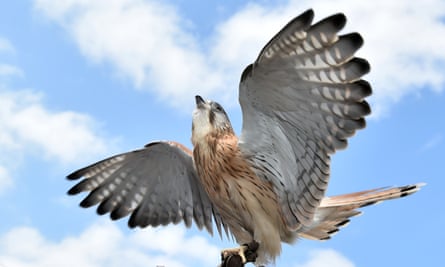Extract from The Guardian
Seeing a wild, swooping kestrel hunt its prey near my Melbourne home was exhilarating. I could taste its freedom.

Last modified on Mon 31 Aug 2020 08.12 AEST
The nankeen kestrel hovered over a patch of saltmarsh, eyes down, wings slowly flapping. After a minute or so, it flew off, displaying gorgeous black and brown plumage, before returning to hover and watch. It dropped suddenly, like a stone flung by a god, then took its prize – a cricket or grasshopper – to a fence post to be eaten in seconds.
The sight of this bird of prey, late in my second week of Melbourne’s hard lockdown, opened something inside me. Like millions of others, I was stuck in the city under curfew, unable to venture more than five kilometres from my home. I yearned for the bush, to be in a place free of cars or houses, where I didn’t have to hear other people’s conversations as we marched up and down the same few paths on our measly hour of daily allotted exercise. That wild, swooping kestrel was exhilarating. I could taste its freedom.
Bird watching is getting me through this lockdown. I’m a novice twitcher. My partner’s the serious one with his high-end binoculars and eBird lists. Mostly, I used to tag along, looking for showy flashes of colour as he parsed the difference between seemingly identical little brown birds. Before coronavirus, we went to the Otways or the Wombat State Forest or Werribee’s Western Treatment Plant. Now we’re locked down in Melbourne’s inner west, thankfully near the beach and the Jawbone Marine Sanctuary, a coastal area near an old rifle range. And when I feel chewed up or stir crazy or an aching, panicky sadness about the state of the world, I go looking for birds.
The fairy wrens are flirty right now. I watched a blue male, so brightly coloured he might have been made of plastic, flutter and hop while two females chased. The spoonbills are industrious, shovelling their long black beaks through the shallows like plump white feeding machines. When I settled in at the Jawbone the other day, I saw a spoonbill and a white-faced heron feeding side by side, two companionable humps.
That same day, I saw three black and white stilts with heads down, picking their way through green and red saltmarsh on long, pink legs. Watching their slow, graceful movements was incredibly soothing. I felt part of something bigger – the natural world going about its business even as my own activities were radically curtailed. As I focused my binoculars on these birds, something orange came into view behind them. I swore loudly. A fox with greedy eyes and a tail like a feather duster was stalking through bushes.
At dusk, the cormorants fly off somewhere in long, wavy lines, threads of black unspooling against the clouds. The blackbirds are starting to sing, evoking bittersweet memories of past, carefree springs. Standing in my backyard recently, after hours spent staring at a computer screen, I looked up into the ash-grey sky and my heart flipped. A tiny armada flew above me: five pelicans in formation.
Each day I remind myself how lucky I am to live near a beach and have a backyard but some of my best bird sightings have been in semi-industrial places. In Yarraville, near the container parks, I watched in shock as 41 yellow-tailed black cockatoos flew by. Where were they going? Where had they been? Riding my bike past the Mobil refinery, I saw a yellow-rumped thornbill, with a black and white speckled head and small, cheery rear, scratching around near a huge oil tank.
Of course, birds don’t exist to soothe and divert humans, even if their beauty, variety and songs are one of the most wondrous things on earth. They are in crisis, thanks to us. Some species were decimated by the recent bushfires. Our threatened birds are declining at an alarming rate. I’m hearing a lot more currawongs in my neighbourhood – are they pushing into new places because of habitat loss or climate change? And late last year, the waterways leading into the Jawbone Marine Sanctuary, where I saw that kestrel and the stilts and spoonbills, turned black after an oil spill from a nearby asphalt plant.
This lockdown has made me profoundly grateful to the people who fought to create native habitats in my formerly industrial, working-class suburb. One area near me, a popular spot for honeyeaters and shorebirds that is thick with casuarinas, grasses and mangroves, was planted partly on coal ash waste from the old Newport Power Station. Another, a lake fringed by gums and wattles (where my partner has seen kingfishers and a goshawk), was created in the 1980s on the site of a massive, bluestone quarry.
The birds are returning to these once denuded places, which I’d previously taken for granted. Right now, they’re helping to keep me sane but when this lockdown is over, I’ll need to do so much more to help them.
• Suzy Freeman-Greene is a Melbourne writer and the arts and culture editor of the Conversation
No comments:
Post a Comment